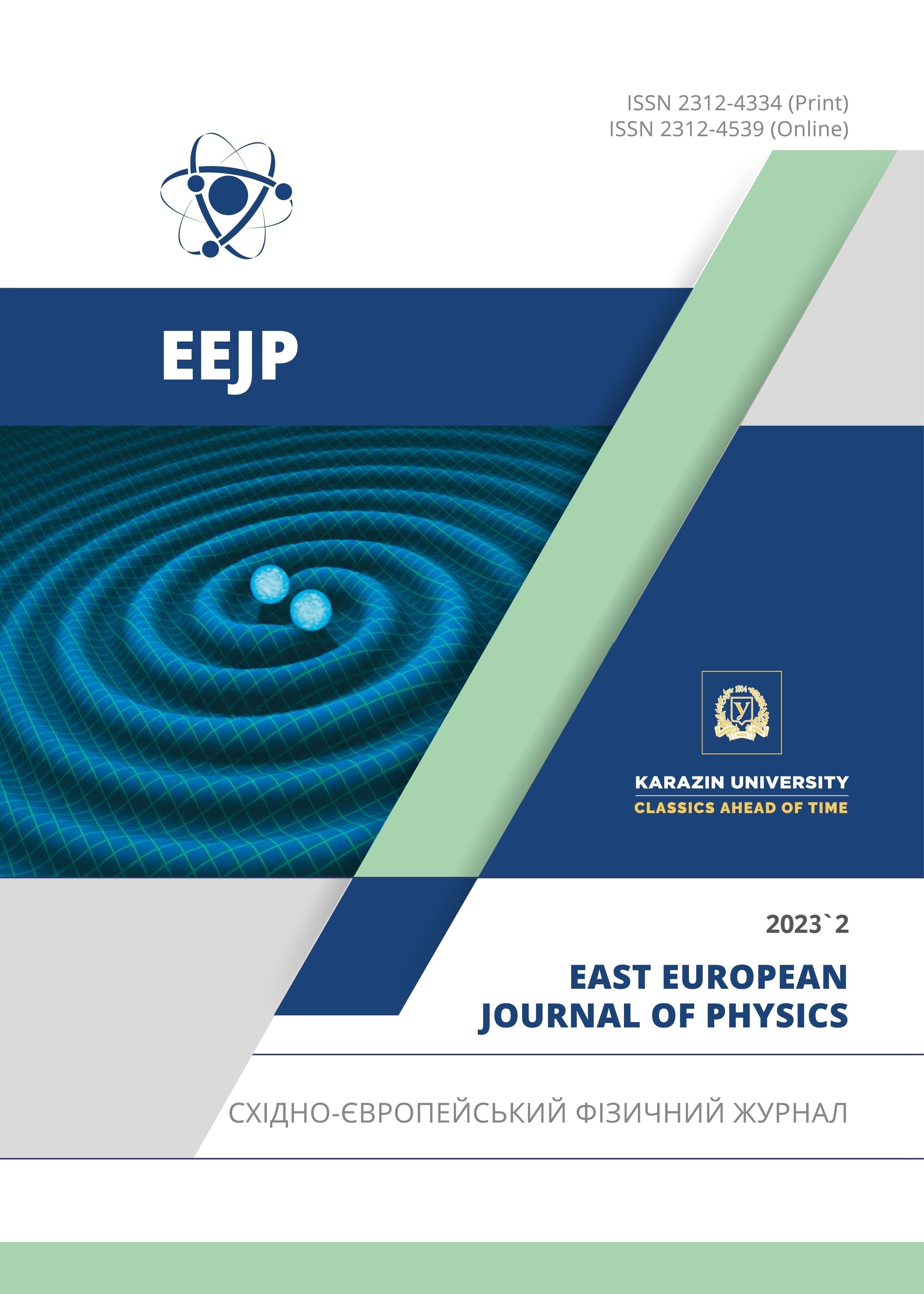Магніто-термоелектричні коефіцієнти сильнолегованого матеріалу n-типу Mg2Si
Анотація
На відміну від параболічної смугової моделі, яка зазвичай використовується для розуміння електронних властивостей загалом, термоелектричних і магнітотермоелектричних зокрема, це дослідження підтверджує результати непараболічної смугової моделі для кращого розуміння коефіцієнтів Зеєбека та Нернста в присутності магнітного поля для Mg2Si. Коефіцієнт магнето Зеєбека був значно підвищений порівняно з ненульовим значенням поля як функція магнітного поля для різних концентрацій електронів у діапазоні 0.6-12×1025/m3 в середньому при кімнатній температурі для непараболічної моделі порівняно з параболічною. модель гурту. Результат для коефіцієнта Нернста демонструє тенденцію до зростання як функції магнітного поля, за винятком певних концентрацій електронів для моделі параболічної зони. Водночас вона зменшується з магнітним полем у середньому для моделі непараболічної зони.
Завантаження
Посилання
P. Boulet, M.J. Verstraete, J.P. Crocombette, M. Briki, and M.C. Record, “Electronic properties of the Mg2Si thermoelectric material investigated by linear-response density-functional theory,” Computational Materials Science, 50(3), 847-851 (2011). https://doi.org/10.1016/j.commatsci.2010.10.020
N.S. Naser, R.V. Denys, H.F. Andersen, L. Arnberg, and V.A. Yartsy, “Nanostructured Magnesium silicide Mg2Si and its electrochemical performance as anode of a Lithium battery,” Journal of Alloys and Compounds, 718, 478-491 (2017). https://doi.org/10.1016/j.jallcom.2017.05.163
T.H. Nguyen, et al., “On the composition of luminescence spectra from heavily doped p-type Silicon under low and high excitation,” Journal of luminescence, 181, 223-229 (2016). https://doi.org/10.1016/j.jlumin.2016.08.036
M.H. Gebru, “Electrical and thermal conductivity of heavily doped n-type silicon,” Eur. Phys. J. Appl. Phys. 90, 10102 (2020). https://doi.org/10.1051/epjap/2020190332
P.W. Chapman, O.N. Tufte, J.D. Zook, and D. Long, “Electrical properties of heavily doped silicon,” J. App. Phys. 34(11), 3291 3295 (2004). https://doi.org/10.1063/1.1729180
W.G. Spitzer, F.A. Trumbore, and R.L. Logan, “Properties of heavily doped n-type germanium,” Journal of Applied Physics, 32, 1822–1830 (1961). https://doi.org/10.1063/1.1728243
A. Cuevas, P.A. Basore, G.G. Matlakowski, and C. Dubois, “Surface Recombination Velocity of Heavily Doped N-Type Silicon,”Journal of Applied Physics, 80, 3370-3375 (1996). https://doi.org/10.1063/1.363250
H. Zhou, P. Kropelnicki, J.M. Tsai, and C. Lee, “Study of the thermoelectric properties of heavily doped poly-Si in high temperature,”Procedia Engineering, 94, 18-24 (2014). https://doi.org/10.1016/j.proeng.2013.10.011
K. Kikuchi, K. Yamamoto, N. Nomura, and A. Kawasaki, “Synthesis of n-type Mg2Si/CNT Thermoelectric Nanofibers,” Nanoscale Res. Lett. 12, 343 (2017). https://doi.org/10.1186/s11671-017-2120-y
D.W. Rowe, editor, Thermoelectric Handbook: Macro to Nano, (CRC Press/Taylor & Francis, Boca Raton, FL, 2006). https://doi.org/10.1201/9781420038903
H. Wiggers, M.M. Schober, R. Koza, and P. Hermann, “Effects of impurity on the lattice dynamics of nanocrystalline silicon for thermoelectric application,” J. Mater. Sci, 48(7), 2836-2845 (2013). https://doi.org/10.1007/s10853-012-6827-y
C.J. Hwang, “Calculation of Fermi energy and band tail parameters in heavily doped and degenerate n-type GaAs,” J. Appl. Phys. 41, 2268-2674 (1970).http://dx.doi.org/10.1063/1.1659280
P.I. Baranskii, V.M. Babich, and E.F. Venger, “Development of The Physical Insight into The Nature of The Factors That Control Electrophysical and Other Properties of Semiconductors, Semiconductor Physics, Quantum Electronics & Optoelectronics, 4(1), 1-4 (2000). http://journal-spqeo.org.ua/users/pdf/n1_2001/001_4_1.pdf
E.O. Kane, “Thomas-Fermi approach to impurity semiconductor band structure,” Phys. Rev. 133,79-88 (1963). https://doi.org/10.1103/PhysRev.131.79
C. Kittel, Introduction to solid state physics, 7th ed. (John Wiley & Sons Inc., New York, 1996).
J.W. Slotboom, “The pn-product in silicon,” Solid-State Electronics, 20(4), 279-283 (1977). https://doi.org/10.1016/0038-1101(77)90108-3
P. Sengupta, Y. Wen, and J. Shi, “Spin-dependent magneto-thermopower in narrow gap lead chalcogenide quantum wells,” Sci. Rep. 8, 5972 (2018). https://doi.org/10.1038/s41598-018-23511-2
V. Zlatić, and R. Monnier, The Modern Theory of Electricity, (Oxford University press, 2014).
M.H. Gebru, “Thermoelectric coefficients of heavily doped n-type silicon,” East. Eur. J. Phys. 4, 189-196 (2021). https://doi.org/10.26565/2312-4334-2021-4-25
M.H. Gebru, “Electrical and thermal conductivity of heavily doped n-type silicon”, Eur. Phys. J. Appl. Phys. 90, 10102 (2020), https://doi.org/10.1051/epjap/2020190332
S.S. Lee, Semiconducor physical electronics, 2nd ed. (Springer, 2006).
S. Majdi, N. Suntornwipat, M. Gabrysch, and J. Isberg, “Carrier scattering mechanisms: Identifications via the scaling properties of the Boltzmann transport equation,” Advanced Theory and Simulations, 4(1), 2000103 (2021). https://doi.org/10.1002/adts.202000103
T.J. Salez, M. Kouyaté, C. Filomeno, M. Bonetti, M. Roger, G. Demouchy, E. Dubois, et al., “Magnetically enhancing Seebeck in ferrofluids,” Nanoscale Adv. 1, 2979-2989 (2019). https://doi.org/10.1039/C9NA00109C
X. Chen, D. Parker, and D.J. Singh, “Importance of non-parabolic band effects, on the thermoelectric properties of semiconductors,” Sci. Rep. 3, 3168 (2013). https://doi.org/10.1038/srep03168
E.F. Scott, K.A. Schlaak, P. Chakraborty, C. Fu, S.N. Guin, S. Khodabakhsh, A.E.P. y Puente, et al., “Doping as Tuning Mechanism for Magneto-Thermoelectric Effects to Improveɀ T In Polycrystalline NbP,” Phys. Rev. B, 107, 115108 (2023), https://doi.org/10.1103/PhysRevB.107.115108
Авторське право (c) 2023 Мулугета Хабте Гебру

Цю роботу ліцензовано за Міжнародня ліцензія Creative Commons Attribution 4.0.
Автори, які публікуються у цьому журналі, погоджуються з наступними умовами:
- Автори залишають за собою право на авторство своєї роботи та передають журналу право першої публікації цієї роботи на умовах ліцензії Creative Commons Attribution License, котра дозволяє іншим особам вільно розповсюджувати опубліковану роботу з обов'язковим посиланням на авторів оригінальної роботи та першу публікацію роботи у цьому журналі.
- Автори мають право укладати самостійні додаткові угоди щодо неексклюзивного розповсюдження роботи у тому вигляді, в якому вона була опублікована цим журналом (наприклад, розміщувати роботу в електронному сховищі установи або публікувати у складі монографії), за умови збереження посилання на першу публікацію роботи у цьому журналі.
- Політика журналу дозволяє і заохочує розміщення авторами в мережі Інтернет (наприклад, у сховищах установ або на особистих веб-сайтах) рукопису роботи, як до подання цього рукопису до редакції, так і під час його редакційного опрацювання, оскільки це сприяє виникненню продуктивної наукової дискусії та позитивно позначається на оперативності та динаміці цитування опублікованої роботи (див. The Effect of Open Access).








